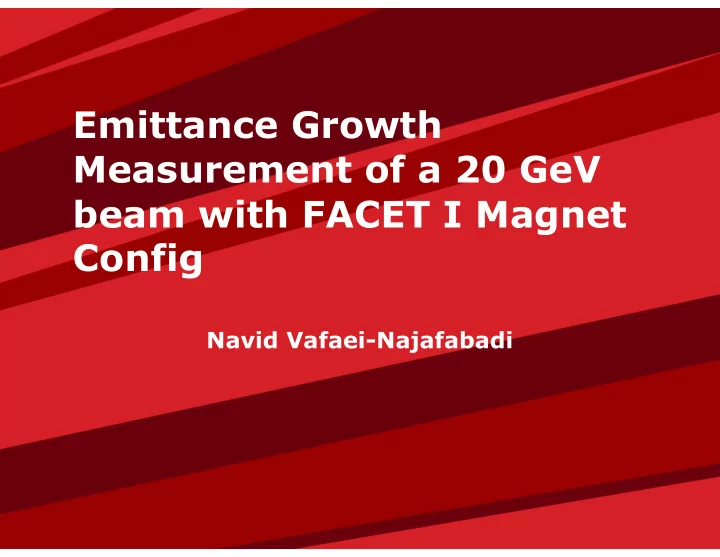

Emittance Growth Measurement of a 20 GeV beam with FACET I Magnet Config Navid Vafaei-Najafabadi
FACET I Spectrometer Layout with Li oven ELANEX Plasma Be QS 2 QS 1 ‘ n e x4e16 Start of Be Al CMOS_ QS 1 QS 2 Elanex Ramp Window Window FAR Relative Z (m) 0 1.55 5.91 9.91 20.31 20.37 21.19 Linac Z (m) 1994.85 1996.4 2000.76 2004.76 2015.16 2015.22 2016.04 2
Models Evolution of Twiss Parameters From Transfer Matrix to evolution of Twiss parameters ! = # $ #′ $′ ‘ Free Propagation in Space: & ' & , ( = 1 * ( & ' & , 0 1 - . , / 0 , a and distance of Be foil from downramp are optimized to produce the fit
� � � � � Models Plasma Ramp: Continuous focusing element with ( ) k = # $%&' = * +, ‘ 1 Be/Al foil: Multiple Scattering Angle Δ" * Quadrupole Focusing, . = /0 # & # & + ( & Δ" ) # $ = # & ( & QS1 ( $ = # & # & + ( & Δ" ) # & - & + = 1 + - ) - $ = QS2 # & # & + ( & Δ" ) ( * Δ" = 8.3 µ rad for 75 µ m Be window and 134 mrad for 5 mm Al
Injected Beam Emittance at ~23 GeV Double Gaussian Fit Optimization Results 𝜗 𝑜 =5 mm-mrad 𝜏 𝑠 =1 𝜈 m ‘ 𝜏 𝑠𝑔𝑗𝑢 =97.3 𝜈m Energy slices equivalent except for energy • Elements affecting beam size measurement • Plasma down-ramp • 75 μ m Be window • Two Quadrupole magnets (QS1,QS2) • 5 mm Al window • 𝜗 𝑜 , 𝜏 𝑠 , α and optimized to produce the fit • 5
Drive Beam Emittance at ~15 GeV 𝜗 𝑜 =584 mm-mrad 𝜏 𝑠 =56 𝜈 m ‘ Energy slices equivalent except for energy • Elements affecting beam size measurement • Plasma down-ramp • 75 μ m Be window • Two Quadrupole magnets (QS1,QS2) • 5 mm Al window • 𝜗 𝑜 , 𝜏 𝑠 , α and optimized to produce the fit • 6
Measuring Emittance of a Beam Accelerated to 20 GeV Configuration • Magnet/foil locations: Same as FACET I • Quad strengths: 258.03,-172.06. • Calculated for imaging at 20.35 GeV, using one ‘ of the DAQ functions. * • Energy for trailing electron beam: 20 GeV ± 1 GeV • Butterfly Profile is plotted for different normalized emittance values and for different initial beam sizes * Image plane at ELANEX (z=2015.22), object plane at 12 cm upstream of the exit of the 1.5 m lithium oven (z=1997.85) — same config as last 1.5 m positron run 7
Emittance of 20 GeV Beam From the End of the Matching Section Butterfly for variation in ϵ n , with 𝜏 r =3 𝜈 m ‘ In a 1 GeV window, the different cases within a factor of two can be distinguished relatively easily 8
Emittance of 20 GeV Beam With FACET I Lithium Ramp Butterfly for variation in ϵ n , with 𝜏 r =1 𝜈 m ‘ Peak density is assumed to be 5x10 16 cm -3 Ramp profile is the same as long plasma Li profile 9
Highly Unmatched Beams in Plasma Butterfly for variation in 𝜏 r , with ϵ n =10 mm-mrad ‘ However, the larger the initial beam size is, the distinction becomes more difficult to make 10
Butterfly Feature for 4µm Initial Size Butterfly for variation in ϵ n , with 𝜏 r =4 𝜈 m inside plasma ‘ Beams of Various emittance below 21 GeV are very difficult to distinguish 11
Conclusions •An optimization routine is used to estimate the parameters of the beam consistent with the beam size observed in a high resolution spectrometer •Emittance of injected beam from E217 is estimated at 5 ‘ mm-mrad, much smaller than the drive beam •The imaging spectrometer can be used to measure the emittance growth of the witness beam in the two bunch experiment in FACET II to accuracy of tens of percent •The more mismatched the beam is, the harder it is to measure emittance growth 12
The End
Checking Optimization Variation ‘ Variation of 𝛙 2 attains a minimum for all three parameters ( σ opt − σ obs ) 2 χ 2 = ∑ σ obs 2 14
Recommend
More recommend